

 The South African
The South African
Preface
In 2015 the author of this article published his book "The South African Territorial Forces (SWATF) 1980-1989". It also described their prehistory, which goes back to the time of the First World War. However, the explanations in this regard were only incomplete due to the lack of information at the time, and besides, it only marginally concerned the actual subject matter of the work.
In the meantime, a wealth of source and literature material has now been found, the evaluations of which made it possible to comprehensively depict the early history of the South African military presence in South West Africa. It is noticeable that until the Second World War the border between the police and the Union Defence Force was fluid, so there was always an exchange of personnel between the two law enforcement officers. This is not surprising, since the police always formed a paramilitary force, which was responsible for both internal security and national defence against external enemies - then in cooperation with the army.
The present treatise begins with the invasion of the South African military into German South-West Africa in 1915 and ends with the establishment of the largely autonomous territorial armed forces in 1980, covering a period of 65 years, although the main focus is on the half century between 1915 and 1966, because this epoch has so far hardly been considered in literature. With the beginning of the bush war on the northern border with Angola, 1966 marked a turning point in the development of security forces on the territory of South West Africa because the functions of the police and defence force not only changed, but also expanded considerably. The years from 1966 to 1980 finally focused on the organisational structure of the state armed forces (SWATF) and have already been described in detail in the book mentioned above. Because the history of the military in the German colonial period up to 1915, i.e. the Imperial Colonial Force (Schutztruppe), had already been sufficiently taken into account in the literature, the presentation of the period in between (1915-1980) now closes a gap, although it cannot be ruled out that more details will be found in the future.
The author expressly thanks Mr Harald Koch and Dr. Andreas Vogt (both Windhoek), in particular but also Messrs. Christo Retief and André Anthonissen from the MOTH Namibia Command Headquarters, who helped him get information without which the research would not have led to the desired success.
The First World War and the subsequent military government (1915-1920)
Just a month after the outbreak of the First World War, South African units had attacked the German police station Ramansdrift on the Orange River and penetrated German South West Africa, but were successfully repelled by the Schutztruppe, which therefore sent strong units to the southern border, although they did expressly not advance into the territory of the South African Union. At the same time troops of the Union Defence Force (UDF) had landed in Lüderitzbucht in September 1914, but they, too, only managed to gradually move further inland from mid-December. The reason for the initial weakness of the South Africans was that many officers from the Boer ranks refused to participate in a war of aggression against German South West Africa. When the government stuck to its plans and established them with commitments to the British Empire, it resulted in a rebellion of nationalist-minded Boers led by a number of generals and the formation of free corps in October 1914. Prime Minister Louis Botha and Defence Minister Jan Smuts, both former Boer generals themselves, were forced to put down the rebellion with government-loyal troops, which dragged on until the end of January 1915. Only then operations against German South West Africa could be resumed.
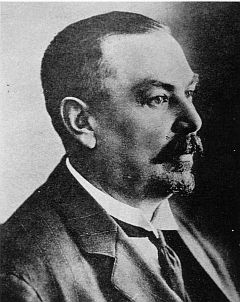
Prime Minister Louis Botha
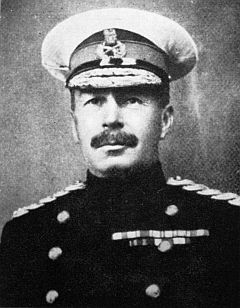
Brigadier General Henry T. Lukin
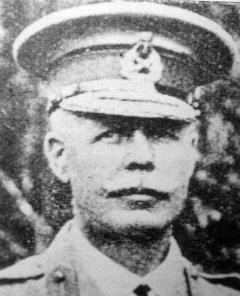
Brigadier General Percival S. Beves
However, the direct military administration lasted only a little more than a quarter of a year, because on October 28, 1915 the "Protectorate of South-West Africa in Military Occupation of the Union Forces" was proclaimed and two days later in the person of Sir Edmond H.L Gorges the previous Chief Civil Secretary was appointed administrator, which marked the future development, because administrators were also at the head of the four South African provinces, and this system was used in South West Africa at a time when the outcome of the war was not yet predictable.
After Botha's departure in July 1915, the UDF, whose strength in the campaign against the Schutztruppe had amounted to almost 43,000 people, was reduced to just 1,000 soldiers who, under martial law, also exercised a police function in South West Africa in the years to 1920. After the departure of the military governor, Brigadier General Beves, her commander became Lieutenant Colonel and soon promoted Colonel Matthys J. de Jager, who had served on the staff of the Permanent Force at the beginning of the war. As early as February 3, 1917, he had to mobilize his troops against the rebellious Chief Mandume ya Ndemufayo from the Uukwanyama area in Ovamboland, who refused to recognize the demarcation between South West Africa and Angola. The ruler died fighting the South Africans three days later. The members of the South African Mounted Riflemen (SAMR), who were stationed in the country until the end of 1919 and were under the command of Lieutenant Colonel W.W Rush, were assigned to the service of the administration and were to form a "SWA Military Force".
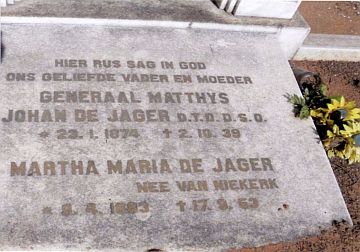
Headstone of Colonel Matthys J. de Jager
Colonel de Jager retired at the end of 1919, and from January 1920 a separate SWA Police was created under the "Deputy Commissioner", Lieutenant Colonel Hedley J. Kirkpatrick. He was an Australian, came to South Africa in 1900 in the Boer War on the British side and in 1902 he served as captain in the service of the South African Constabulary (SAC), where he soon became an inspector for the Transvaal Police. As Lieutenant Colonel and Commander of the 2nd South African Scottish Regiment, he took part in the campaign in German South West Africa in 1914/15, then in 1916/17 as Commander of the 9th South African Infantry Battalion in German East Africa, before he took on the task in 1920 as "Deputy Commissioner of Police" in South West Africa.
Major Christian A.B van Coller became Divisional Inspector with effect from January 1, 1920, who replaced Kirkpatrick as Deputy Commissioner the following year when he returned to the South African Union after the end of the military government and the beginning of mandate.
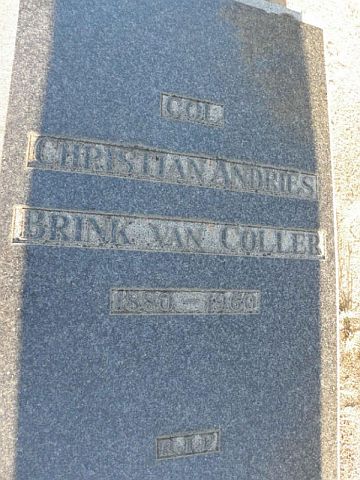
Headstone of Major Christian A.B van Coller
The mandate from 1921 to 1939
Meanwhile, on December 17, 1920, a treaty between the League of Nations and South Africa officially confirmed the transfer of the mandate, in which German South-West Africa was "transferred to the British crown for the benefit of the Union of South Africa". Under international law, the mandate came into force on January 1, 1921 by the proclamation of the Governor General the following day ("Indemnity and Withdrawal of Martial Law" No. 1 of 1921), thereby abolishing martial law and the previous protectorate became the "Mandated Territory of South West-Africa". Gysbert R. Hofmeyr took office as the first administrator after the status of the mandate on October 1, 1920, replacing Sir Gorges.
At the end of May 1922, the new armed forces of the mandate were first used when the Bondelswarts-Nama rose in the south of the country against the South African administration. The uprising was put down by a group of 22 officers, 348 non-commissioned officers and team ranks, and members of rifle clubs also took part in their ranks on a voluntary basis, with two mountain guns and four machine guns as well as two aircraft from the South African Air Force being used as support. The Bondelswarts surrendered after a few days, more than a hundred of whom had died, while there were only two deaths on the South African side. Otherwise, Prime Minister Smuts had instructed Lieutenant Colonel H.F Trew, the chief of the South African Police in the western districts of the Cape Province, to stay out of the clashes in South West Africa and only to ensure that no insurgents crossed the border over the Orange River. Nonetheless, Major Anton J.F. Prins was sent as UDF liaison officer to assist the SWA administrator. Hofmeyr himself had taken over the management of the military operations and "temporarily" awarded himself the rank of colonel on May 23, 1922, because the senior officer, Jacob A.D. Kruger, was "only" a lieutenant colonel and he did not want to wait until a suitable officer would arrive from Pretoria. Hofmeyr was later sharply criticized for the decision because he had no military knowledge and therefore presented himself as a pitiful "amateur", which is why security forces strongly recommended that an experienced officer be given command of future operations of this kind. In fact, they drew consequences from the situation, because the command structure was different in the next internal riots that broke out on the territory of Rehobother Baster only three years later.
In the meantime the "Citizen Force Proclamation" took place in January 1923, with which a kind of volunteer militia, like the Landwehr in Prussia, was to be set up for the defence of the mandate area and for which already officers were appointed. This system of military service was then supplemented or modified by two further proclamations in 1924 and 1927. Major van Coller remained head of the police administration (Commissioner of SWA Police), assisted by lieutenants H.C. du Preez, F. McQuoid Mason and H.F. Prinsloo as sub-inspectors.
In April 1925, the Rehobother Baster revolted because the administration intended, among other things, to restrict their autonomy rights. Initially, 157 police officers led by Major van Coller were deployed, at the same time the new Citizen Force was mobilized, which finally consisted of 36 officers as well as 428 non-commissioned officers and team ranks and units from the districts of Aroab, Bethanien, Gibeon, Keetmanshoop, Maltahöhe, Okahandja, Rehoboth, Warmbad and Windhoek. This force, together with the 157 policemen, in the order of 621 men, was placed under the command of Colonel M.J. de Jager, who had left the service in 1919, had worked as a farmer and merchant since then and was now being reactivated. The armed forces surrounded the town of Rehoboth, at the same time air support was requested, which arrived in the form of three planes from the Union and threatened with the bombing. This demonstration of power was sufficient for the Rehobother Baster to surrender, which ended the uprising without any bloodshed.
In the same year (1925), the rifle clubs founded in 1921 were replaced by "rifle practices", shooting exercises that were regularly held according to the regulations of the Citizen Force and were also under their control. In 1927, the Citizen Force (SWA) was officially established as a defence force for the mandate territory. Chief Commandant was Colonel de Jager, Chief Staff Officer Major van Coller and Staff Adjutant Captain W.G.C. Steyn, and a permanent headquarters for the troops was established in Windhoek. At the end of the same year, two more appointments were made: Major E. Richardson as Director of Supply and Replenishment and Major L.F. Fourie as Director of Medical Services. However, the global economic crisis soon became noticeable in South Africa, too, and the position of Staff Adjutant had to be cancelled again in 1931 due to financial constraints, and the position of Chief Commandant was also converted into an honorary post. But that meant the extensive dissolution of the structure of the Citizen Force, whose operational capability was practically no longer available, and so the national defence was again with the police as the more or less armed force. In the directory of authorities from 1936 van Coller, who had since been promoted to lieutenant colonel, appeared as "Commander of the State Police and Troops ", in the capital of Windhoek supported by Major H.C. du Preez as Chief Inspector and Lieutenant J.W. Naude as Sub-Inspector. The mandate area was divided into five police districts: Police District No. 1, Windhoek, with (Chief) Inspector H.C. du Preez as Officer Commanding (OC), Police District No. 2, Keetmanshoop, with Inspector F. McQuoid Mason as OC, Police District No. 3, Lüderitz, with Sub-Inspector E.R. Howe as OC, Police District No. 4, Grootfontein, with Sub-Inspector C.J. Uys as OC and Police District No. 5, Omaruru, with Sub-Inspector J. Haagen as OC.
In July and August of 1932, the deployment of the police force was again required, because Chief Iipumba ya Tshilongo from the Uukwambi area in Ovamboland had for years permanently disregarded the authority of the administration and was not impressed by the threat of violence. When he attacked the Finnish mission station Elim being on his territory with 300 warriors, because they gave shelter to his daughter Neekulu, whom he wanted to marry - which was forbidden according to tribal custom - that filled the cup to the brim. Although the attack was unsuccessful, administrator Albertus J. Werth was now challenged to demonstrate strength in order to preserve the government's reputation. As, after his meeting with van Coller, a campaign by infantry and cavalry alone in the impassable terrain could have led to high losses, the decision was made to request support from Pretoria, whereupon the UDF arranged for two armoured cars and three aircraft to be deployed. Since the chief still could not comply with the call to surrender to the armed forces, the Air Force first bombed the chief's kraal and then set it on fire. The chief himself escaped, but was arrested and detained after an unsuccessful attempt to cross the Angola border. Since he had left the borders of his domain, which he was not allowed to do according to tribal custom, he had discredited himself as chief and thus lost his power. He spent the next few years in exile imposed in the Kavango, but returned to his original home in 1938, where he died in 1959. At any rate, the use of the aircraft had a lasting effect on the other chiefs of Ovamboland and made a significant contribution to consolidating the authority of the administration.
During 1938 and 1939 there were various attempts to revive the Citizen Force, and a cadet school was even established. In March 1939 there was also a draft for the deployment of an infantry battalion, which was to consist of 29 officers, 402 non-commissioned officers and team ranks. At that time, Austria and Sudetenland were annexed to the German Reich in Europe, and German troops entered Czechoslovakia and Memelland, which gave many Germans in South West Africa hope that their homeland would soon become German again. On April 15, 1939, when the British secret service believed that it had discovered a corresponding "conspiracy" in the mandate, the South African Union sent between 300 and 400 heavily armed police officers equipped with machine guns and armoured vehicles to Windhoek as a precautionary measure and "demonstration of power" to support the weak police force there. A representative of the SWA Germans in the State Council and the Executive protested this measure because it violated the South West Africa Constitution Act (No. 42 of 1925), which said that the country's police force was independent, but South Africa had put a bill in place to unify the police force of the mandate area with that of the Union a short time previously, in March 1939, which was then implemented on June 1 of the year and which ended the SWA Police.
The Second World War and the years after that until 1966
With the Union Government Proclamation No. 234 of 1939 on October 9, after the start of the Second World War, the provisions of South African Defence Law No. 13 of 1912 were also extended to South West Africa. As a result, in November 1939, the military district sub area South West Africa (SWA Command) was founded with headquarters in Windhoek (established in 1940), which initially comprised a volunteer Citizen Force, a standby company and a signal corps. SWA Command's first officer commanding, under the command of the Union Defence Force General Staff, became Lieutenant Colonel Christian A.B. van Coller, the commander of the state police, who resigned from his previous position in late January 1940 as part of a major ceremony. He was assisted by two staff officers and two office workers or secretaries as typists. Colonel M.J. de Jager, who was originally scheduled to be promoted to general, died suddenly in 1939. Born in 1872, he joined the State Artillery of the South African Republic as a lieutenant in 1899 when the Boer War began. Captured by the British in January 1902 and exiled to St. Helena, he continued to serve in the Transvaal Police force after the war and returning to South Africa. With the campaign in 1914/15 he came to South West Africa, where he then served as commander of the armed forces and police under administrator Sir Gorges until he retired in 1919. He then stayed in the country, settled at Windhoek as a farmer and merchant and became chairman of the SWA Land Board. He was also chairman of the Zuid-West-Afrika Vereeniging, which aimed to promote cooperation between Germans and Afrikaaners (Boers) until he became chief commandant of the newly founded Citizen Force in 1927. In the 1930s, he was also the chairman of the Economic Party and deputy chairman of the Chamber of Agriculture.
On December 1, 1939, the 1st SWA Infantry Battalion (1 SWA Inf Bn) under Lieutenant Colonel E.W. Bassingthwaighte (commander until 1942) was set up from 2,000 volunteers, whose headquarters with another staff officer was also located in Windhoek. It formed a unit of the UDF's Active Citizen Force and also maintained contingents in Grootfontein, Kalkfeld, Keetmanshoop, Okahandja, Otjiwarongo and Outjo, as well as artillery and air defence contingents in Walvis Bay. After the battalion was initially used to guard the SWA German internees, it was transferred to the Union in 1940 and there was put into mobile condition on June 22 of the same year. It subsequently served in the war in North Africa, but also within South Africa. After the capitulation of German and Italian troops in North Africa in May 1943, the battalion's forces from there returned to the South African Union, and a month later the entire organization was disbanded and released to Windhoek.
As early as September 22, 1939, the first air force unit in the country to form the 16 bomber squadron was activated in Walvis Bay. It had been moved here from Germiston and consisted of six officers and twelve soldiers or non-commissioned officers, who had three converted Ju 86 aircraft that had previously been used for passenger traffic by South African Airways (SAA).
In the course of 1940, 32 rifle clubs were founded in the mandate area, which were organized into four commands. However, in the same year they were replaced by 17 National Reserve Volunteer Units. These were dissolved after the war on March 31, 1947, but some of their activities continued until December 15, 1948, when the Rifle Clubs were converted into Rifle Commandos. In 1957 seven commandos were formed: Etosha (with Grootfontein and Otavi), Northern SWA (Okahandja, Otjiwarongo and Outjo), North Western SWA (Karibib, Omaruru, Swakopmund and Usakos), Central SWA (Windhoek), Southern SWA (Bethanien, Karasburg) , Keetmanshoop and Lüderitz), Gibeon (with Aranos, Gochas, Maltahöhe, Mariental and Stampriet) and Gobabis (with Leonardville). In 1967, under the then OC SWA Command, Commandant Magnus A. de M. Malan, who later became Chief of the SADF and South African Defence Minister, the structure was reorganized, which led to more than a doubling of the number of commands, namely 15. In the same year a 16th command was founded in Oranjemund, and new ones were added in the following years.
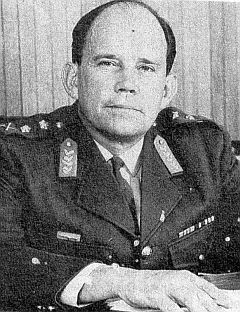
Brigadier Magnus A. de M. Malan
On October 1, 1961, the South African Air Force (SAAF) took over the newly expanded Rooikop airfield near Walvis Bay. A garrison for up to 3,000 soldiers was subsequently built on the old strip of land on the lagoon, and here the 2 South African Infantry Battalion Group was established on January 1, 1962. At the beginning of July 1961, South African generals had already met with the city's mayor to find a suitable site for an SADF military base.
Every year in the winter month of July there was a three-week manoeuvre by the Windhoek Regiment, at which senior commanders from Pretoria were often present. In 1961, the Army Chief of Staff, Combat General Sybrand A. Engelbrecht, personally inspected the field service exercises held at Hochfeld, which were led by Commandant Siegfried Engels, the commanding officer of the regiment. The manoeuvres always ended with a parade of troops on Windhoeker Kaiser Street and a subsequent regimental ball. (Note: The designation of a Combat General stood for a Major General in the SADF from 1960 to 1968, the Commandant replaced the Lieutenant Colonel since 1950.)
The first Officer Commanding (OC) SWA Command, Lieutenant Colonel Christian A.B. van Coller (born in 1880), retired in 1943. He died in 1960 as a colonel and was buried in Gammans Cemetery in the Pioneerspark district of Windhoek, where his grave still exists today. Van Coller's successor was the previous Chief Inspector and OC Police District No. 1, Windhoek, Lieutenant Colonel Hermanus C. du Preez, which shows that the lines between the police and the military were very fluid at the time. In fact, the police in South and South West Africa always had a paramilitary function. When du Preez took office in Windhoek, he had previously participated in the war between Italians and British in East Africa (Abyssinia and Somaliland 1940-1942). In 1946, he was replaced in South West Africa by Lieutenant Colonel J.J.C. Venter. He had been a major in the SA Staff Corps since October 1939 and then worked as an Assistant Adjutant General SA Forces in East Africa. He was also the first military commander in Windhoek. Venter's successor in 1949 was Lieutenant Colonel Jacobus J.C. Hamman, who had been commandant of the South African Military College until 1938 and then served with Venter in the SA Staff Corps. He left South West Africa after three years, and was replaced by Commandant Martin E. Fourie, who remained until 1961. He had been a member of the Permanent Force since 1931 and served as a liaison officer in the Middle East at the beginning of the Second World War. 1942 deputy commander of the Botha Regiment, the following year he was assigned to the British Army, in whose ranks he worked as an intelligence officer, at last in Northern Greece. After the war, he was a general staff officer at Cape Command before being named commander in Windhoek in 1952. The next OC SWA Command was Commandant P.E. Ferguson from 1961 to 1963, who had commanded the 1 Special Services Battalion as a major from 1949 to 1951. He was succeeded by Commandant Frederich W. Loots, who stayed only a year and then went on to a steep career: 1966-1970 Director of Military Intelligence, 1970-1973 Inspector General of the SADF and finally in 1974 until his retirement as Major General in 1982 GOC (General Officer Commanding) Special Forces. In Windhoek, Loots was followed in 1964 by Commandant W.J. Coetser, who moved to Combined Fighting Forces headquarters two years later.
In early 1966, Commandant Magnus A. de M. Malan took over the post of OC SWA Command, and in his two years in Windhoek the so-called bush war i.e. the armed struggle of 1980-1990 Minister of Defence SWAPO began. It naturally followed that the South African military presence in the country was far more important than before. This was already reflected in the fact that Malan was promoted to colonel at the end of 1966 and was the first commander of the military area to rise to this rank. Malan then seems to have done his job so well - just a year later, at the end of 1967 and thus shortly before he left South West Africa, he was even appointed Brigadier - that his senior officers became aware of him and in the following years he was conferred highest command posts that could be reached, as his career shows: 1968-1972 OC Military Academy, 1972-1973 OC Western Province, 1973-1976 Chief of the Army, 1976-1980 Chief of the SADF.
From the beginning of the bush war to the establishment of state-owned armed forces
Small groups of SWAPO fighters had operated on the border between Angola and Ovamboland since the mid-1960s. The first major confrontation at Ongulumbashe ("Operation Blouwildebees") on August 26, 1966 between the South African Police (SAP) and guerrillas of NAPLA (Namibian People's Liberation Army), the armed arm of SWAPO, renamed People's Liberation Army of Namibia (PLAN) at the turn of the year 1969/70, was the beginning of the violent clashes. At that time, the border security was still exclusively with the South African Police, but it soon became clear that the task alone was overwhelming and, above all, inadequately equipped, as was evident in further terrorist attacks in the following years. For this reason, "Military Area No. 1" with the headquarters in Rundu was established, which, however, was spun off from the defence area of SWA Command and placed under its own commander (Colonel B. de Wet Roos). The first units of the SADF were dispatched on January 26, 1972, the state of emergency was imposed on Ovamboland on February 4 of the year - which was extended to all of north-western South West Africa four years later - and on April 1, 1973 control over the northern border finally passed from SAP to the responsibility of the South African Defence Force. At the same time, the Military Area No. 1 was divided into operating zones: Eastern Caprivi (1 sub area), Kavango (2 sub area), Owambo (3 sub area), and in 1974 West Caprivi was added as 4 sub area. In June of that year, the military and police together numbered around 15,000 men in the country.
On June 1, 1967, the Namutoni Regiment was formed, a second infantry unit, which was initially based in Otjiwarongo, but moved to Windhoek in 1971, and the Erongo Regiment was formed in March 1968. In 1964 and 1967 two maintenance companies were activated, in 1967 the 16th Field Squadron, which was used as the first national unit in the operational area on the Angolan border in 1976, and in 1975 the 27th Field Regiment was established. In addition, there was the nationwide structure of the commandos since 1957.
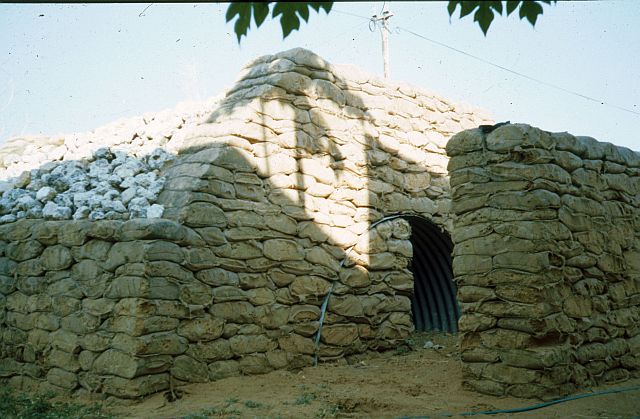
Shelter (bunker) in Rundu
Malan's successor as OC SWA Command was Brigadier Andre J. van Deventer in early 1968. He had previously commanded the 2 SA Infantry Battalion in Walvis Bay (1965-1968). After two years, he initially left South West Africa to act as OC Orange Free State Command and OC North West Command. From 1974 to 1975, as a major general, he was commanding officer of the 1st South African Corps, before taking over the newly founded 101 Task Force in November of last-mentioned year, a special task force in Military Area No. 1. But already in 1976 he was promoted to Lieutenant General as Chief of Staff Finance and transferred to Pretoria. From 1980 until his retirement in 1985, he was Secretary of the State Security Council for the President of the Republic of South Africa.
In 1970, Brigadier Benjamin de Wet Roos, who had commanded the newly formed Military Area No. 1, had succeeded van Deventer. Three years later Roos was replaced by Brigadier Johannes J. Geldenhuys, who had been stationed in the country since 1970, where he headed the operations department at the OC SWA Command as a staff officer. In 1973 he set up the 1st Brigade of the SADF ("Oefening Swaland Blits") in Walvis Bay. In 1974 he was recalled to Pretoria, where he initially served as head of military intelligence and then chief of the Army Operations Department before returning to his previous post in Windhoek in 1977 as a major general, but this time with significantly expanded powers as the political and the military situation had exacerbated. In the meantime, Brigadier Dirk R. Marais served as OC SWA Command from 1974 to 1976. He had previously been a military attaché at the South African Embassy in Bonn and later held the position of Deputy Chief of the Army until he retired in 1987 as a major general. In South West Africa he was succeeded at the turn of the year 1976(77 by Brigadier Louw E. Oosthuizen, who had already been stationed in the country for 15 months at the end of the 1960s and worked as a military attaché at the South African Embassy in Paris from 1973 to 1976. After leaving Windhoek in mid-1977, he became Director of Logistic Operational Staff in Pretoria.
On August 1, 1977, J.J. Geldenhuys took over the position of commander in the military area of South West Africa again. If this had previously been held by a staff officer, in the past few years by a brigadier, Geldenhuys as General Officer Commanding (GOC) was the first officer to hold this post, which was associated with an upgrade of the SWA Command. Also connected with this was the fact that he then commanded all military units in the country (GOC SA Army Forces in SWA), while until that time the defence forces deployed in the operational area had been directly subordinate to the SADF leadership in Pretoria. In this respect, as the previous head of the Army Operations Department, he had gained important experience that predestined him for his job in South West Africa, because since the beginning of the bush war on the Angolan border, the South African military presence had grown in importance from year to year.
The organizational measures that Major General Geldenhuys undertook in the following period initially covered the division of the country into sectors. In early 1976, Military Area No. 1 was divided by moving Ovamboland and Kaokoveld under Colonel Andreas J. Liebenberg to Military Area No. 2 combined with headquarters in Oshakati, while Eastern Caprivi and Kavango continued to form the 1st area, whose headquarters were moved from Rundu to Grootfontein in March 1976 under Major General Constand L. Viljoen, where a new military camp was completed in September 1977. When Viljoen became Chief of the Army in September 1976, Major General Ian R. Gleeson took the lead in the operational area. The South African armed forces had already withdrawn from southern Angola in March 1976, leaving 45,000 SADF soldiers on the ground in South West Africa. Major General Geldenhuys moved his headquarters back to Windhoek in January 1978, where it was initially housed in a part of the Eros airfield before moving to the city centre a month later, which became known as the "Bastion". The headquarters unit, however, was stationed on the military base in the Suiderhof district of Windhoek.
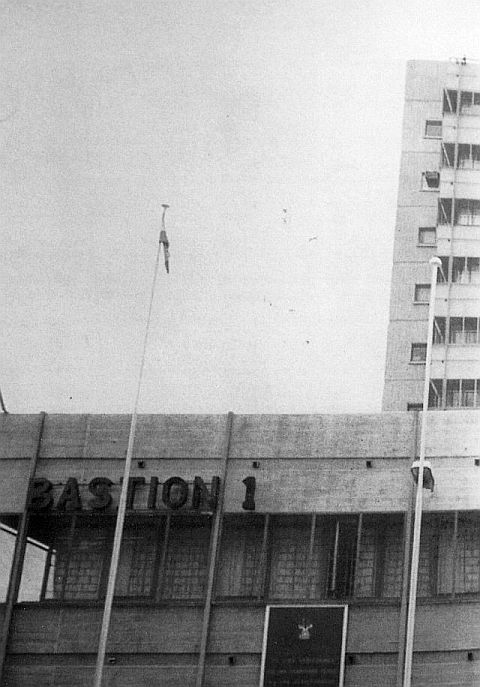
Headquarters in Windhoek [Bastion]
After the first unit consisting of black soldiers had been founded in South Africa in 1975 with the 21st Battalion, which was soon to prove itself, it was only logical to extend this concept to South West Africa with the intention of keeping its population as a whole in the long term to participate in national defence. This is how the 1st Ovambo Battalion came into being at the end of 1974, followed by the 1st Kavango Battalion a year later. In addition, in 1974 and 1975 two companies from San (Bushmen) were established in West Caprivi, which were combined to form a battalion in 1976, a battalion in Eastern Caprivi was added in August 1977, one in Bushmanland in May/June 1978 and one in Kaokoveld in 1979 (already set up as a company in April 1978). Finally, with the takeover of Major General Geldenhuys in accordance with his mandate to build up an independent South West African army, a multiethnic battalion with five companies was subsequently established at the locations Narubis (consisting of Namas), Kamanjab (consisting of Damaras) and Otjosondu (consisting of Hereros), Drimiopsis (consisting of Coloureds and Hereros) and Nauaspoort (consisting of Rehobother Basters and Coloureds). This foundation was preceded in September 1976 by the creation of a separate command of the Basters.
From 1978, the division of the South West African territory looked like this:
Sector 10 (old Military Area No. 2): Kaokoveld and Owambo (headquarters in Oshakati)
Sector 20 (old Military Area No. 1): Kavango, West Caprivi and Bushmanland (headquarters in Rundu)
Sector 70 (old Military 1 sub area): Eastern Caprivi (headquarters in Katima Mulilo)
Sector 30: headquarters in Otjiwarongo
Sector 40: headquarters in Windhoek
Sector 50: headquarters in Gobabis
Sector 60: headquarters in Keetmanshoop
The battalions were also given new names: the previous 1st Ovambo battalion became the 35th battalion, the 1st Kavango battalion the 34th battalion. The Bushman Battalion in West Caprivi was the 31st Battalion then, that one in the Bushmanland the 36th Battalion, and the Caprivi Battalion in Eastern Caprivi became the 33rd Battalion. The multi-ethnic unit was called 41st Battalion from the start, and the Kaokoveld Company became 37th Battalion in 1979. In addition, there was the 32nd ("Buffalo") Battalion since 1976, a special unit stationed in Bagani (Buffalo) in the West Caprivi. It was made up of former Angolan FNLA soldiers and remained a South African unit even after 1980 when the South West Africa Territory Force was formed.
On August 30, 1979, new uniforms for the future national armed forces were presented at the headquarters in Windhoek, and after the National Assembly had been constituted, work began in 1979 to set up an autonomous administrative service independent of South Africa. On July 1, 1980, a Council of Ministers with executive powers was formed, which soon also included a "Secretary of Defence", who acted as commander (GOC) SWATF and, in a third function, was also commander of the South African units stationed in the country, with which it then had two headquarters in Windhoek. Finally, on August 1, 1980, the South West Africa Territory Force (SWATF) were officially founded, completing the formation of these state armed forces initiated three years earlier, and Major General Johannes J. Geldenhuys can be regarded as its "architect". In addition, a separate SWA Military School was established in Okahandja at the turn of 1979/80.
Although the strength of SWATF, according to Major General Geldenhuys, was primarily in the fields of infantry and logistics, there was also a small air force unit that had existed before 1980. It all started in 1963 when Colonel Hans H. Denk launched the 112th Command Squadron, which consisted exclusively of South West Africans from the vigilante group, who made their own aircraft available as part of the militia concept. After the flare-up of the fighting at the Angolan border, the unit became part of the South African Air Force (SAAF), which was responsible for all air operations, and which was a small detachment for it in May 1968 (301st Air Division) as part of the 1st small aircraft command stationed in Rundu, which was intended as air support for the South African Police (SAP), being still responsible for border security at that time. To celebrate the 60th anniversary of the South African Air Force on February 2, 1980, the members of the 112th squadron appeared for the last time in South African uniforms, since meanwhile South West Africans who served in the SWATF had indeed been given their own uniform (although there was, as already mentioned, only one uniform for all branches of the armed forces). With the founding of the SWATF on August 1, 1980, the previous 112th Squadron became the 1st SWA Squadron and thus the state-owned Air Force SWA/Namibia. As they only had light aircraft ("small war forces "), their functions lay in connecting and reconnaissance flights and the evacuation of wounded, and were also used in civilian emergencies. Colonel Denk, who had given command of the squadron to Lieutenant Colonel Piet Gous in 1979, was appointed honorary colonel three years later. For the rest, the Air Force remained part of the SAAF until the very end. In 1977 the Western Air Command was founded in Windhoek, which existed until 1989 and which was also responsible for the tactical operations of the 1st SWA Squadron - in consultation with the SWATF commander, to whom it had been subordinate since 1980.
A new chapter in the armed forces of South West Africa/Namibia began in 1980, which has already been described in detail. Nevertheless, the commanders of SWATF, Major General Charles J. Lloyd (1980-1983), Major General Georg L. Meiring (1983-1987) and Major General Willie C. Meyer (1987-1989) were also GOC SWA Command until the very end.
Staff
Commanding officer of the Union Defence Force (UDF) in German South West Africa
11.02.1915 - 09.07.1915 Prime Minister General Louis Botha
Commander of the UDF in South West Africa
09.07.1915 - 11.07.1915 Brigadier General Henry T. Lukin
Military Governor of the Protectorate of South West Africa
11.07.1915 - 30.10.1915 Brigadier General Percival S. Beves
Commander of the UDF under the Protectorate
1915-1919 Colonel Matthys J. de Jager
(Deputy) Commissioner SWA Police
1920-1921 Lieutenant Colonel Hedley J. Kirkpatrick
1921-1939 Lieutenant Colonel Christian A.B van Coller
Chief Commandant of the Citizen Force (SWA)
1927-1939 Colonel Matthys J. de Jager
Officer Commanding (OC) SWA Command (from 1977 GOC)
04.11.1939 - 30.09.1943 Lieutenant Colonel Christian A.B. van Coller
01.10.1943 - 30.06.1946 Lieutenant Colonel Hermanus C. du Preez
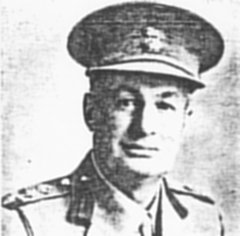
Lieutenant Colonel Hermanus C. du Preez
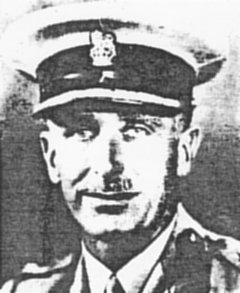
Lieutenant Colonel Jacobus J.C. Hamman
01.06.1952 - 30.06.1961 Commandant Martin E. Fourie
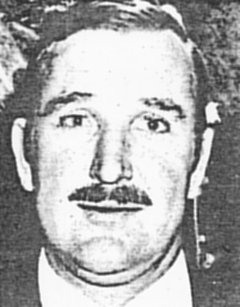
Commandant Martin E. Fourie
01.07.1961 - 31.07.1963 Commandant P.E. Ferguson
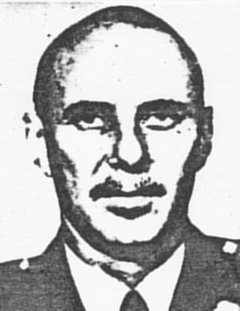
Commandant P.E. Ferguson
01.08.1963 - 30.11.1964 Commandant Frederich W. Loots
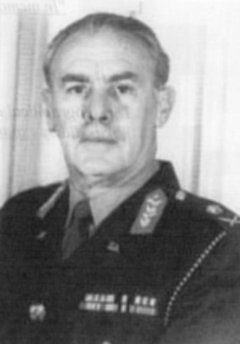
Commandant Frederich W. Loots
01.12.1964 - 31.01.1966 Commandant W.J. Coetser
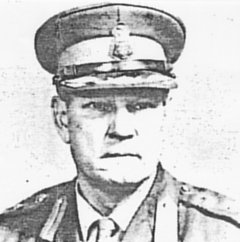
Commandant W.J. Coetser
01.02.1966 - 31.03.1968 Brigadier Magnus A. de M. Malan
01.04.1968 - 30.06.1970 Brigadier Andre J. van Deventer
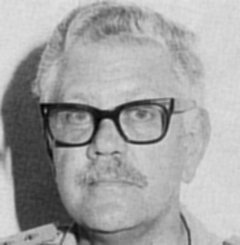
Brigadier Andre J. van Deventer
01.07.1970 - 30.09.1973 Brigadier Benjamin de Wet Roos
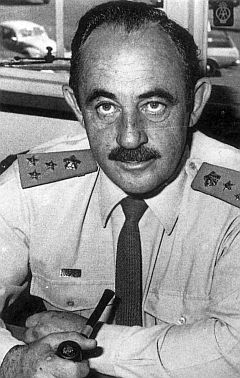
Brigadier Benjamin de Wet Roos
01.10.1973 - 15.11.1974 Brigadier Johannes J. Geldenhuys
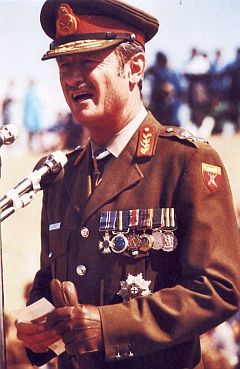
Brigadier Johannes J. Geldenhuys
16.11.1974 - 28.12.1976 Brigadier Dirk R. Marais
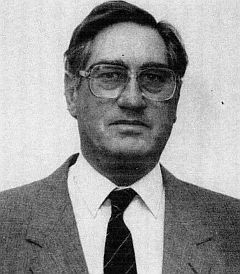
Brigadier Dirk R. Marais
01.01.1977 - 31.07.1977 Brigadier Louw E. Oosthuizen
01.08.1977 - 06.09.1980 Major General Johannes J. Geldenhuys
(from 01.08.1980 at the same time Chief SWATF)
07.09.1980 - 09.11.1983 Major General Charles J. Lloyd (also Chief SWATF)
10.11.1983 - 23.01.1987 Major General Georg L. Meiring (also Chief SWATF)
24.01.1987 - 21.03.1990 Major General Willie C. Meyer (until 27.05.1989 also Chief SWATF)
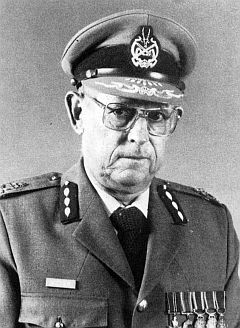
Major General Willie C. Meyer
Sources and Literature